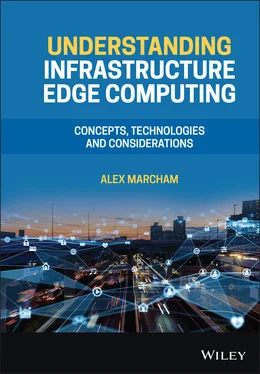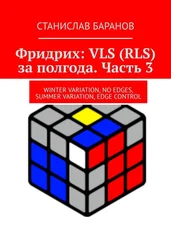Alex Marcham - Understanding Infrastructure Edge Computing
Здесь есть возможность читать онлайн «Alex Marcham - Understanding Infrastructure Edge Computing» — ознакомительный отрывок электронной книги совершенно бесплатно, а после прочтения отрывка купить полную версию. В некоторых случаях можно слушать аудио, скачать через торрент в формате fb2 и присутствует краткое содержание. Жанр: unrecognised, на английском языке. Описание произведения, (предисловие) а так же отзывы посетителей доступны на портале библиотеки ЛибКат.
- Название:Understanding Infrastructure Edge Computing
- Автор:
- Жанр:
- Год:неизвестен
- ISBN:нет данных
- Рейтинг книги:4 / 5. Голосов: 1
-
Избранное:Добавить в избранное
- Отзывы:
-
Ваша оценка:
- 80
- 1
- 2
- 3
- 4
- 5
Understanding Infrastructure Edge Computing: краткое содержание, описание и аннотация
Предлагаем к чтению аннотацию, описание, краткое содержание или предисловие (зависит от того, что написал сам автор книги «Understanding Infrastructure Edge Computing»). Если вы не нашли необходимую информацию о книге — напишите в комментариях, мы постараемся отыскать её.
Understanding Infrastructure Edge Computing
infrastructure edge computing
Understanding Infrastructure Edge Computing
Understanding Infrastructure Edge Computing — читать онлайн ознакомительный отрывок
Ниже представлен текст книги, разбитый по страницам. Система сохранения места последней прочитанной страницы, позволяет с удобством читать онлайн бесплатно книгу «Understanding Infrastructure Edge Computing», без необходимости каждый раз заново искать на чём Вы остановились. Поставьте закладку, и сможете в любой момент перейти на страницу, на которой закончили чтение.
Интервал:
Закладка:
Library of Congress Cataloging‐in‐Publication Data Names: Marcham, Alex, author. Title: Understanding infrastructure edge computing : concepts, technologies and considerations / Alex Marcham. Description: Hoboken, NJ, USA : Wiley, 2021. | Includes bibliographical references and index. Identifiers: LCCN 2020050691 (print) | LCCN 2020050692 (ebook) | ISBN 9781119763239 (hardback) | ISBN 9781119763246 (adobe pdf) | ISBN 9781119763253 (epub) Subjects: LCSH: Edge computing. Classification: LCC QA76.583 .M37 2021 (print) | LCC QA76.583 (ebook) | DDC 005.75/8–dc23 LC record available at https://lccn.loc.gov/2020050691LC ebook record available at https://lccn.loc.gov/2020050692
Cover Design: Wiley
Cover Image: © Metamorworks/Shutterstock
To the Fun Police. Careful!
Preface
How to Use This Book
This book is intended to be read from start to finish in order for the reader to get the most benefit from all of the subject areas which it covers. However, for information on a specific topic, each of the chapters in this book can be read in a relatively stand‐alone manner. There is crossover between chapters in many cases, for example, between a section on the physical redundancy of an edge data centre facility in one chapter and a section describing infrastructure edge computing network level resiliency in another, where if the reader has not read the prior section, some context may be lost.
I hope however you choose to read it that you enjoy reading this book as much as I did when writing it.
About This Book
As with any emerging area of technology, the information presented within this book represents a moment in time and the best practices available at that moment in time. The information here is represented to the best of the author’s knowledge and does not favour one vendor over another.
Audience
This book was written for an audience of technologists, decision makers, and engineers in the fields of telecommunications, networking, data centres, and application development and operation who are interested in new emerging areas of technology, such as edge computing, fifth generation (5G), and distributed artificial intelligence (AI).
About the Author
Alex Marcham has been in the networking industry for over a decade working on wireless networks, enterprise networks, telecommunications, and edge computing. He created the terms infrastructure edge and device edge and was the primary author of the Open Glossary of Edge Computing, which is now a Linux Foundation project. When not at work, he can often be seen hiking somewhere remote.
Acknowledgements
This book would not have come to fruition were it not for the help of a few special people.
First, I would like to thank the friends whom I share each day with as we all do our best to keep each other moderately sane from one week to the next. I’ll always do my best to listen and help you as you each do for me, and I wish you all the greatest happiness and success in life. That is, unless one of you says that my hair is rubbish again, in which case we will be forced to engage in a cage fight.
Second, thank you to my family. Although we may spend a lot of time apart, physical distance is no match for our combined love of badgers, elephants, and hummingbirds. That said, it is a lot easier to maintain a set of hummingbird feeders than it would be to provide for a load of badgers or a passing herd of elephants, but this is matched by the difficulty of photographing any hummingbird properly.
Third, thanks to the team at Wiley for their insight and support for this project from start to finish. The telepathic portion of this book will be available at a later date, so this will have to do for now.
Finally, thanks to everyone I have spoken to and learned from on the topics of engineering, writing, and life in the past three decades across the world. We are the sum of our choices and experiences.
1 Introduction
Few could have guessed the impact the internet would have on us all at its inception. Today, the internet and the services it provides are essential for billions of people across the world. It is a primary source of communication with friends, family, and our communities; it is the primary way in which we access many essential services, as well as the way that increasing numbers of us go to work, pursue our educational goals, and access sources of entertainment, all on demand.
We did not get to this point by accident. Although the current state of the internet could not have been fully foreseen decades ago, it is due to the continuous efforts of skilled and driven people from across many different disciplines that the modern internet is able to support us as it does today. The story of the internet is not one of a single grand original design; it is one of consistent iteration and ingenuity to adapt to new technical and business challenges which have emerged over the decades.
As they have in the past, new and emerging use cases are driving the evolution of internet and data centre technology. This is resulting in new generations of infrastructure which are reimagining how the internet that we all use on a daily basis should be designed, deployed, and operated as a whole.
Distributed artificial intelligence (AI) and machine learning (ML) are set to permanently reshape how many industries, from healthcare and retail to manufacturing and construction, operate due to their ability to enhance the decision‐making process and automate difficult tasks with extraordinary speed and precision. City‐scale internet of things (IoT) and cyber‐physical systems provide machines the means to interact physically with our world in ways that have been impossible or impractical to achieve before, supported by fifth generation (5G) cellular network connectivity and new versions of cloud computing, which are able to support high‐bandwidth, low‐latency, and real‐time use cases.
The key element underpinning all of these areas of advancement in both technology and business is infrastructure edge computing. It is one thing to demonstrate a use case in a laboratory environment where everything is a known variable; it is quite another to then operate a commercial service in the real world with all of the messy constraints that introduces, from cost to performance to timescales.
Edge computing is one of the most frequently mentioned emerging technologies, which many believe will make a significant impact on the landscapes of both technology and business during the decade of the 2020s. The concept seems simple: By moving compute resources as close as possible to their end users, theoretically the latency between a user and their application can be reduced, the cost of data transport can be minimised, and these two factors combined will make new use cases practical.
But what really is edge computing, beyond the hype, marketing material, and hyperbole that always accompany any major technological shift? With so many competing definitions of even the most basic elements of the technology, can we succinctly define concepts and terminology which allow us to have a consistent understanding of the challenges we are trying to solve together as an industry?
What are the key factors driving edge computing, and what must a solution provide in order to solve key technical and business challenges? How does edge computing really replace, compete with, or augment cloud computing? What is infrastructure edge computing, and does it stand alongside the traditional regional, national, and on‐premises data centre, or does it seek to replace them entirely?
This book aims to answer all of these questions and provide the reader with a solid foundation of knowledge with which to understand how we got to this inflection point and how infrastructure edge computing is a vital component of the next‐generation internet – an internet which enables suites of new key use cases that unlock untapped value globally across many different industries.
Читать дальшеИнтервал:
Закладка:
Похожие книги на «Understanding Infrastructure Edge Computing»
Представляем Вашему вниманию похожие книги на «Understanding Infrastructure Edge Computing» списком для выбора. Мы отобрали схожую по названию и смыслу литературу в надежде предоставить читателям больше вариантов отыскать новые, интересные, ещё непрочитанные произведения.
Обсуждение, отзывы о книге «Understanding Infrastructure Edge Computing» и просто собственные мнения читателей. Оставьте ваши комментарии, напишите, что Вы думаете о произведении, его смысле или главных героях. Укажите что конкретно понравилось, а что нет, и почему Вы так считаете.












